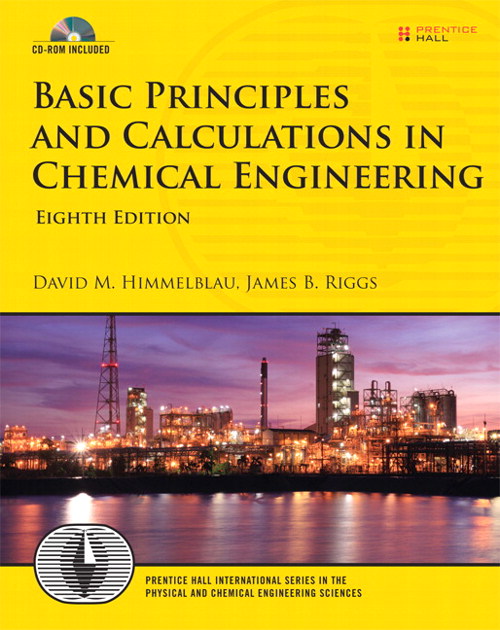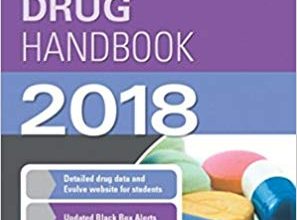
دانلود کتاب Basic Principles and Calculations in Chemical Engineering (8th Edition)
cost of Ebook is 15$ .Email us to download the Ebook. To be sure, you can request to submit several sample pages from the book.
مشخصات ایبوک Basic Principles and Calculations in Chemical Engineering 8 Edition

Basic Principles and Calculations in Chemical Engineering, Eighth Edition
By: David M. Himmelblau; James B. Riggs
Publisher: Prentice Hall
Pub. Date: May 31, 2012
unknown: 9780132885478
Print ISBN-10: 0-13-234660-5
Print ISBN-13: 978-0-13-234660-3
Web ISBN-10: 0-13-288547-6
Web ISBN-13: 978-0-13-288547-8
ISBN-13: 9780132346603
ISBN-10: 0132346605
Pages in ٍEbook Edition: 856
Price : 15$
درباره نسخه الکترونیکی کتاب basic principles and calculations in chemical engineering 8th edition pdf download
Basic Principles and Calculations in Chemical Engineering, Eighth Edition goes far beyond traditional introductory chemical engineering topics, presenting applications that reflect the full scope of contemporary chemical, petroleum, and environmental engineering. Celebrating its fiftieth Anniversary as the field’s leading practical introduction, it has been extensively updated and reorganized to cover today’s principles and calculations more efficiently, and to present far more coverage of bioengineering, nanoengineering, and green engineering.
Offering a strong foundation of skills and knowledge for successful study and practice, it guides students through formulating and solving material and energy balance problems, as well as describing gases, liquids, and vapors. Throughout, the authors introduce efficient, consistent, student-friendly methods for solving problems, analyzing data, and gaining a conceptual, application-based understanding of modern chemical engineering processes. This edition’s improvements include many new problems, examples, and homework assignments.
Coverage includes
Modular chapters designed to support introductory chemical engineering courses of any length
Thorough introductions to unit conversions, basis selection, and process measurements
Consistent, sound strategies for solving material and energy balance problems
Clear introductions to key concepts ranging from stoichiometry to enthalpy
Behavior of gases, liquids, and solids: ideal/real gases, single component two-phase systems, gas-liquid systems, and more
Self-assessment questions to help readers identify areas they don’t fully understand
Thought/discussion and homework problems in every chapter
New biotech and bioengineering problems throughout
New examples and homework on nanotechnology, environmental engineering, and green engineering
Extensive tables, charts, and glossaries in each chapte
Many new student projects
Reference appendices presenting atomic weights and numbers, Pitzer Z factors, heats of formation and combustion, and more
Practical, readable, and exceptionally easy to use, Basic Principles and Calculations in Chemical Engineering, Eighth Edition, is the definitive chemical engineering introduction for students, license candidates, practicing engineers, and scientists.
CD-ROM INCLUDES
The latest Polymath trial software for solving linear, nonlinear, and differential equations and regression problems
Point-and-click physical property database containing 700+ compounds
Supplemental Problems Workbook containing 100+ solved problems
Descriptions and animations of modern process equipment
Chapters on degrees of freedom, process simulation, and unsteady-state material balances
Expert advice for beginners on problem-solving in chemical engineering
فهرست مطالب کتاب basic principles and calculations in chemical engineering 8th edition pdf
Title Page
Copyright Page
Dedication Page
Contents
Preface
Read Me
Learning Aids
Good Learning Practices (Learning How to Learn)
Suggestions to Enhance Learning
Suggestions for How to Use This Book Effectively
Acknowledgments
About the Authors
Part I. Introduction
Chapter 1. What Are Chemical Engineering and Bioengineering?
Looking Ahead
1.1. Introduction
1.2. A Brief History of Chemical Engineering
1.3. Where Do Chemical and Bioengineers Work?
1.4. Future Contributions of Chemical and Bioengineering
1.5. Conclusion
Looking Back
Glossary
Web Site
Chapter 2. Introductory Concepts
Looking Ahead
2.1. Systems of Units
Frequently Asked Questions
Self-Assessment Test
2.2. Conversion of Units
Self-Assessment Test
2.3. Dimensional Consistency
Self-Assessment Test
2.4. Significant Figures
Self-Assessment Test
2.5. Validation of Results
Self-Assessment Test
2.6. The Mole and Molecular Weight
Self-Assessment Test
2.7. Choosing a Basis
Self-Assessment Test
2.8. Density and Specific Gravity
Self-Assessment Test
2.9. Concentration
Self-Assessment Test
2.10. Temperature
Self-Assessment Test
2.11. Pressure and Hydrostatic Head
Self-Assessment Test
2.12. Flow Rate
Self-Assessment Test
Looking Back
Glossary
Supplementary References
Web Sites
Problems
Part II. Material Balances
Chapter 3. Material Balances
3.1. Introduction to Material Balances
Self-Assessment Test
3.2. A General Strategy for Solving Material Balance Problems
Self-Assessment Test
Looking Back
Glossary
Supplementary References
Problems
Chapter 4. Material Balances without Reaction
Frequently Asked Questions
Self-Assessment Test
Looking Back
Glossary
Supplementary References
Answer to the Puzzle
Chapter 5. Material Balances Involving Reactions
5.1. Stoichiometry
Self-Assessment Test
5.2. Terminology for Reaction Systems
Self-Assessment Test
5.3. Species Mole Balances
Self-Assessment Test
5.4. Element Material Balances
Self-Assessment Test
5.5. Material Balances for Combustion Systems
Self-Assessment Test
Looking Back
Glossary
Supplementary References
Problems
Chapter 6. Material Balances for Multi-Unit Systems
Looking Ahead
6.1. Primary Concepts
6.2. Sequential Multi-Unit Systems
Self-Assessment Test
6.3. Recycle Systems
Self-Assessment Test
6.4. Bypass and Purge
Self-Assessment Test
6.5. The Industrial Application of Material Balances
Looking Back
Glossary
Supplementary References
Problems
6.2. Sequential Multi-Unit Systems
6.3. Recycle Systems
6.4. Bypass and Purge
Part III. Gases, Vapors, and Liquids
Chapter 7. Ideal and Real Gases
7.1. Ideal Gases
Self-Assessment Test
7.2. Real Gases: Equations of State
Self-Assessment Test
7.3. Real Gases: Compressibility Charts
7.4. Real Gas Mixtures
Self-Assessment Test
Looking Back
Glossary
Supplementary References
Web Sites
Problems
7.4. Real Gas Mixtures
Chapter 8. Multiphase Equilibrium
Looking Ahead
8.1. Introduction
8.2. Phase Diagrams and the Phase Rule
Self-Assessment Test
8.3. Single-Component Two-Phase Systems (Vapor Pressure)
Self-Assessment Test
8.4. Two-Component Gas/Single-Component Liquid Systems
Self-Assessment Test
Self-Assessment Test
Self-Assessment Test
8.5. Two-Component Gas/Two-Component Liquid Systems
Self-Assessment Test
8.6. Multicomponent Vapor-Liquid Equilibrium
Looking Back
Glossary
Supplementary References
Web Sites
Problems
8.3. Single-Component Two-Phase Systems (Vapor Pressure)
8.4. Two-Component Gas/Single-Component Liquid Systems
8.5. Two-Component Gas/Two-Component Liquid Systems
Part IV. Energy
Chapter 9. Energy Balances
Looking Forward
9.1. Terminology Associated with Energy Balances
Self-Assessment Test
9.2. Types of Energy to Be Included in Energy Balances
Self-Assessment Test
Self-Assessment Test
Self-Assessment Test
Self-Assessment Test
Self-Assessment Test
Self-Assessment Test
Self-Assessment Test
Self-Assessment Test
9.3. Energy Balances without Reaction
Self-Assessment Test
Self-Assessment Test
Self-Assessment Test
Looking Back
Glossary
Supplemental References
Web Sites
Problems
Chapter 10. Energy Balances: How to Account for Chemical Reaction
10.1. The Standard Heat (Enthalpy) of Formation
Self-Assessment Test
10.2. The Heat (Enthalpy) of Reaction
Self-Assessment Test
10.3. Integration of Heat of Formation and Sensible Heat
Self-Assessment Test
10.4. The Heat (Enthalpy) of Combustion
Self-Assessment Test
Looking Back
Glossary
Supplemental References
Problems
Chapter 11. Humidity (Psychrometric) Charts and Their Use
Looking Ahead
11.1. Terminology
Self-Assessment Test
11.2. The Humidity (Psychrometric) Chart
Frequently Asked Questions
Self-Assessment Test
11.3. Applications of the Humidity Chart
Self-Assessment Test
Looking Back
Glossary
Supplementary References
Web Sites
Problems
Part V. Supplementary Material
Chapter 12. Analysis of the Degrees of Freedom in Steady-State Processes
Looking Ahead
12.1. Main Concepts
Looking Back
Self-Assessment Test
Supplementary References
Problems
Chapter 13. Heats of Solution and Mixing
Looking Ahead
13.1. Heats of Solution, Dissolution, and Mixing
Self-Assessment Test
13.2. Introducing the Effects of Mixing into the Energy Balance
Self-Assessment Test
Looking Back
Glossary
Supplementary References
Web Sites
Problems
Chapter 14. The Mechanical Energy Balance
Looking Ahead
14.1. Ideal Reversible Processes
Self-Assessment Test
14.2. Efficiency
Self-Assessment Test
14.3. The Mechanical Energy Balance
Self-Assessment Test
Looking Back
Glossary
Supplementary References
Web Sites
Problems
Chapter 15. Liquids and Gases in Equilibrium with Solids
Looking Ahead
15.1 Main Concepts
Self-Assessment Test
Glossary
Supplementary References
Web Site
Problems
Chapter 16. Solving Material and Energy Balances using Process Simulators (Flowsheeting Codes)
Looking Ahead
16.1. Main Concepts
Looking Back
Supplementary References
Web Sites
Problems
Chapter 17. Unsteady-State Material and Energy Balances
Looking Ahead
Looking Back
Self-Assessment Test
Supplementary References
Web Sites
Appendixes
Appendix A. Answers to Supplemental Questions and Problems
Chapter 2
Chapter 3
Chapter 4
Chapter 5
Chapter 6
Chapter 7
Chapter 8
Chapter 9
Chapter 10
Chapter 11
Appendix B. Atomic Weights and Numbers
Appendix C. Tables of the Pitzer Z0 and Z1 Factors
Appendix D. Heats of Formation and Combustion
Appendix E. Answers to Selected Problems
Chapter 2
Chapter 3
Chapter 4
Chapter 5
Chapter 6
Chapter 7
Chapter 8
Chapter 9
Chapter 10
Chapter 11
Appendix F. Physical Properties of Various Organic and Inorganic Substances
Appendix G. Heat Capacity Equations
Appendix H. Vapor Pressures
Appendix I. Heats of Solution and Dilution
Appendix J. Enthalpy-Concentration Data
Appendix K. Thermodynamic Charts
Appendix L. Physical Properties of Petroleum Fractions
Appendix M. Solution of Sets of Equations
M.1. Independent Linear Equations
M.2. Nonlinear Independent Equations
Supplementary Reference
Appendix N. Fitting Functions to Data
Index
Problems Workbook Index
CD-ROM Warranty
Where are the Companion Content Files?
کتاب Basic Principles and Calculations in Chemical Engineering (8th Edition) (Prentice Hall International Series in the Physical and Chemical Engineering Sciences) 8th Edition
Title
Basic Principles and Calculations in Chemical Engineering
Always learning
Prentice Hall international series in the physical and chemical engineering sciences
Authors
David Mautner Himmelblau, James B. Riggs
Edition
illustrated
Publisher
FT Press, 2012
ISBN
0132346605, 9780132346603
Length 945 pages
Subjects
Science
› Chemistry
› Industrial & Technical
Science / Chemistry / Industrial & Technical
Technology & Engineering / Chemical & Biochemical



